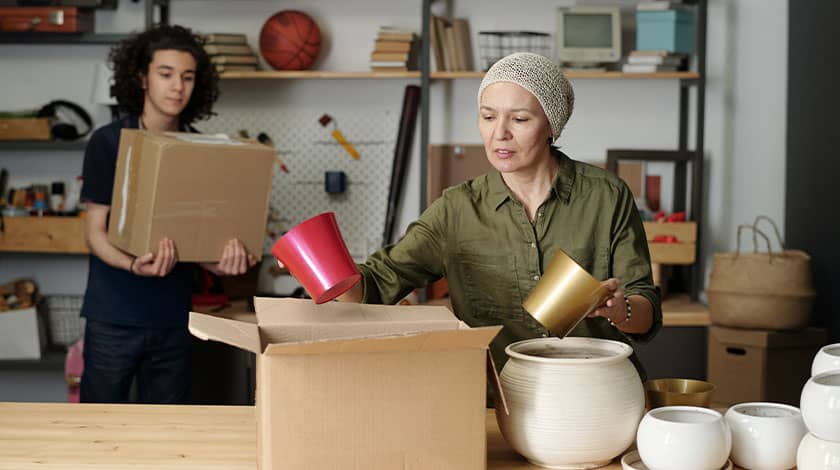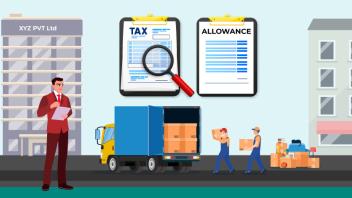Best Practices for Packing and Moving a Store Room or Garage

Moving a storeroom or garage can be quite challenging, especially when it contains various items, such as hand tools, power tools, automotive tools and accessories, storage items, sports and recreational equipment, paint and painting supplies, cleaning supplies, ladders etc.
This blog will discuss the best practices for packing and moving a storeroom or a garage, highlighting the importance of each tip, common mistakes, and how to do it properly.
Inventory and Categorize Items
Taking inventory and categorizing items allows you to know what you have, making it easier to organize, pack, and move.
Common mistakes: Skipping this step or doing it haphazardly.
How to do it properly: Create a list of all items in your storeroom or garage. Categorize them by type, such as hand tools, power tools, sports equipment etc.
Organize and Pack Sports and Recreational Equipment
Sports and recreational equipment like bikes, skateboards, and camping gear can be bulky and challenging to pack. Proper packing and organization ensure their safe transportation and prevent damages.
Common Mistakes: People often overlook proper padding and wrapping, which can lead to damages during the move. They also tend to pack all items together, which can result in tangled or misplaced items.
How to Do It Properly: Disassemble large items and pack smaller parts in labeled bags or boxes. Wrap each item with bubble wrap or moving blankets to prevent damages.
For example, if you're moving bikes, remove the pedals and wheels, and secure them with cable ties. For camping gear, use durable containers to keep them organized and safe. Make sure to label your moving boxes to facilitate easy unpacking at the destination.
Safely Pack Paint and Painting Supplies
Proper packing of paint and painting supplies is crucial to prevent spills and leakages that can damage your other belongings during the move.
Common Mistakes: People often forget to seal paint cans tightly, which can lead to leakages. Additionally, they may pack paint with other items, increasing the risk of damage.
How to Do It Properly: Seal paint cans with plastic wrap and use a rubber mallet to secure the lids tightly. Place paint cans in a sturdy box lined with plastic, and fill any empty spaces with packing material to keep them in place. Wrap painting supplies like brushes, rollers, and trays in plastic bags before packing them in a separate box. For more packing tips, refer to our household packing tips guide.
Pack Cleaning Supplies with Care
Proper packing of cleaning supplies ensures that they don't spill or leak during the move, preventing damage to your other belongings.
Common Mistakes: People often pack cleaning supplies with other items or don't use appropriate packing materials, resulting in spills and damages.
How to Do It Properly: Pack cleaning supplies in a separate, sturdy box lined with plastic. Make sure to wrap bottles containing liquids in plastic bags and secure them with rubber bands. Use packing material to fill empty spaces in the box to prevent shifting during transportation. Check out our kitchen packing and moving tips for more advice on packing liquid items.
Safely Pack and Move Ladders and Step Stools
Ladders and step stools are essential items for reaching high shelves and performing various tasks. Proper packing and transportation ensure their safe arrival at your new location.
Common Mistakes: People often forget to secure ladders and step stools during transportation, which can lead to damages or accidents.
How to Do It Properly: Wrap ladders and step stools in moving blankets or bubble wrap to protect them from scratches and dents. Secure them in the moving truck using ropes or straps to prevent movement during transit. Read our guide on how to pick the right moving truck size for more information on transporting large items.
Disassemble and Pack Workbenches
A sturdy workbench is essential for completing various projects and repairs. Proper disassembly and packing ensure its safe transportation and prevent damages.
Common Mistakes: People often try to move workbenches without disassembling them, increasing the risk of damage or injury.
How to do it properly: To move a workbench, first, remove any attached tools or accessories and pack them separately. Next, disassemble the workbench by removing the legs and any other removable parts. Wrap each part in moving blankets or bubble wrap to protect them from scratches and dents during transportation. Place the parts in a labeled box, and use packing material to fill any empty spaces to prevent movement during transit. For more advice on moving large items, check out our guide on how to move heavy furniture.
Secure and Pack Power Tools
Power tools are expensive and essential for many DIY projects and repairs. Proper packing ensures their safe transportation and prevents damages.
Common Mistakes: People often pack power tools without securing them properly, which can lead to damages or accidents during transportation.
How to Do It Properly: Remove any batteries or detachable parts from power tools before packing. Wrap each tool in bubble wrap or moving blankets to protect them from scratches and dents. Place the tools in a sturdy box with sufficient padding, and use packing material to fill any empty spaces to prevent movement during transit. Label the box clearly to make unpacking easier at your new location.
Pack and Move Outdoor Items
Outdoor items like patio furniture, gardening tools, and lawn equipment should be properly packed and transported to prevent damage during the move.
Common Mistakes: People often overlook cleaning and preparing outdoor items for transportation, which can result in damages or the spread of dirt and debris during the move.
How to Do It Properly: Clean and dry outdoor items before packing them. Disassemble large patio furniture and wrap each part in moving blankets or bubble wrap. Pack gardening tools and lawn equipment in sturdy boxes with padding to prevent damage. For items like lawnmowers, drain the fuel and oil before transportation.
Disassemble Large Items
Disassembling large items, such as furniture and equipment, will make them easier to transport and reduce the risk of damage during the move. Sorting and categorizing your items is essential as it helps maintain organization during the packing process. By grouping similar items together, you can streamline the packing process and make it easier to locate specific items when unpacking at your new location. It also helps ensure that fragile or valuable items are packed with extra care to minimize the risk of damage.
Common mistakes: People often attempt to move large items without disassembling them, which can result in damage or injury.
How to do it properly: Follow the manufacturer's instructions for disassembling items, and use the appropriate tools. Keep all hardware and small parts in labeled bags or containers to make reassembly easier. If you're unsure how to disassemble something, follow these steps to disassemble furniture easily.
Pack Items Securely
Properly packing your items will help prevent damage during transit. Disassembling large items, such as furniture or equipment, is crucial for a smoother moving experience. It makes items more manageable and easier to transport, reducing the risk of damage to both the items themselves and your property. Disassembly can also save space in the moving truck, allowing for a more efficient loading process.
Common mistakes: Overpacking boxes, not using enough padding, and not properly securing items are all common packing mistakes.
How to do it properly: Wrap fragile items in bubble wrap or packing paper, and use packing peanuts or crumpled paper to fill empty spaces in boxes. Make sure boxes are not too heavy to lift and are securely taped shut.
Label Boxes Clearly
Clear labeling of boxes will help ensure that items are placed in the correct rooms upon arrival at your new home, making the unpacking process more efficient. Labels also help movers or anyone assisting you in the move to handle boxes appropriately, particularly if they contain fragile or valuable items. Proper labeling minimizes confusion and prevents any unnecessary mix-ups.
Common mistakes: People often neglect to label boxes or use vague labels, making it difficult to find specific items during the unpacking process.
How to do it properly: As you pack each box, write a detailed description of its contents and the room it belongs to on the outside. You can also use a color-coding system or numbered labels to make the process even more organized. Check out this guide on labeling boxes for more tips.
Plan the Moving Process
A well-planned moving process will help minimize stress and prevent mishaps during the move. Packing fragile items with extra care is essential to prevent breakage or damage during transit. Fragile items can be expensive or hold sentimental value, and proper packing ensures they arrive at your new location intact. By investing time and effort in packing these items securely, you can avoid costly replacements or repairs.
Common mistakes: People often underestimate the amount of time and effort required for a move, leading to last-minute scrambling and increased stress levels.
How to do it properly: Create a moving day checklist and timeline, outlining each task that needs to be completed. Consider factors such as truck rental, packing, loading, unloading, and unpacking.
Hire Professional Help If Needed
Hiring professional packers and movers can save you time, effort, and reduce the risk of damage to your belongings. Hiring professional help can be crucial for a successful move, particularly if you have heavy, bulky, or valuable items that require special handling. Professional movers have the necessary experience, tools, and equipment to ensure your items are packed, loaded, and transported safely and efficiently. Hiring professionals can also save you time and effort, reducing the physical and emotional stress of moving.
Common mistakes: People often attempt to handle the entire moving process on their own, which can be overwhelming and result in damage or injury.
How to do it properly: Research and compare different packers and movers to find the best option for your needs. Verify their qualifications and read reviews to ensure they are reliable and trustworthy.
Use Proper Loading and Unloading Techniques
Using proper loading and unloading techniques will help prevent damage to your belongings and reduce the risk of injury. Safe transportation is vital to prevent damage or loss of your items during the move. Ensuring you have the right size moving truck, adequate loading and unloading equipment, and appropriate packing materials contributes to a secure and successful move. Safe transportation also reduces the risk of injuries and accidents during the moving process.
Common mistakes: People often load items haphazardly, without considering weight distribution or the risk of damage.
How to do it properly: Distribute the weight of your belongings evenly throughout the moving truck and secure items to prevent shifting during transit. Use proper lifting techniques to avoid injury, such as how to lift heavy boxes correctly. Utilize the best loading and unloading equipment to make the process more efficient and safe.
Packing and moving a garage or shed can be a daunting task, but with proper planning and following these best practices, you can ensure a smooth and stress-free move. Remember to declutter, pack items safely and securely, label boxes, hire professional help if needed, and take care of post-move tasks to help you settle into your new home with ease.
By following these best practices for packing and moving a garage or shed, you can ensure a smoother and more organized moving experience. Remember that adequate preparation, organization, and attention to detail can make all the difference in the success of your move. Don't hesitate to seek professional help if needed to ensure your belongings are safely and efficiently transported to your new garage.











